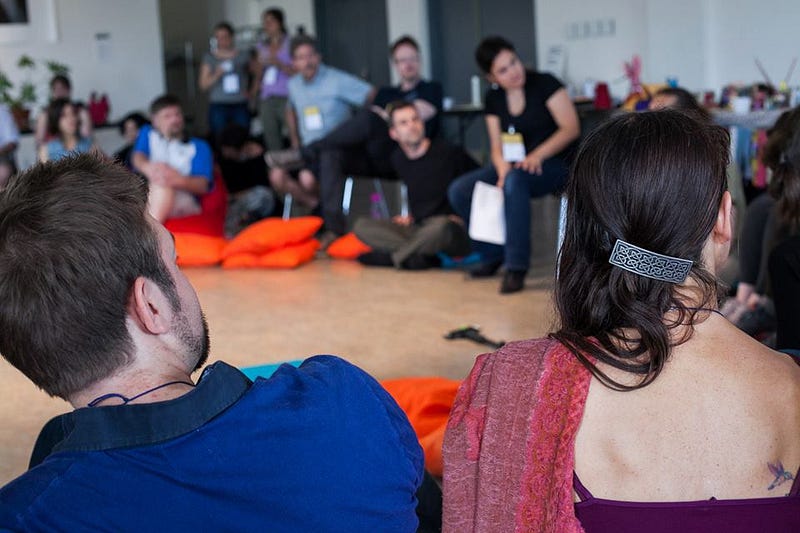Excerpts from a blog written by Connor Turland. The full text and its resources were published on Medium.![]()
As the evolution of a social movement to meet the worlds challenges progresses, it draws itself inwards ever closer to the human heart. There was a surge of the use of the phrase “co”: “co-presence, co-creation, cooperation, collaboration”, bringing our awareness inwards from “fixing the world” to our immediate relationships. Now is the time in the movement to embrace the “self”. Self-awareness, self-management, self-authorship, and self-organization become the learning edge.
Meaning is all we want. Choices are all we make. Relationships are all we have. — Sandy Schuman
Our impact is all that we own. — Jean Roberts
It was my long-time mentor Jean Robertson who introduced me to the phrase ‘self-authoring people in self-organizing communities’. That was probably 4 years ago, at least. I’ve learned a lot more about what she meant by that now, and more importantly, I’ve been seeing that vision come to life.
The phrase points at two fundamental aspects of transformation underway within society. One is the transformation of the self. The other is the transformation of the group. Both are equally important, and are symbiotic with the other.
I am called to share about what I notice happening here, because I find it one of the most deeply moving, and deeply hopeful things that I engage with each day. This post will be a basic introduction to this movement, and point you to some of the edges where this transformation is happening. So what is self-authorship, and what is self-organization?
Self-authoring
The most powerful place to find strength, in the end, is within. For me, self-authorship is the ultimate foundation for any other transformation we wish to see in the world.
The phrase ‘self-authoring’ draws together two foundational aspects: self-authorship and self-authority.
Self-authorship has to do with narrative, and the stories we tell ourselves. Self-authorship is about placing myself in the driver’s seat of my own life. Not only do I have the power to write the story of how my day is going to go, the story of the future, but I have the opportunity to continually re-write the story of my past. I can develop an empowering understanding of the things that have happened. There is a powerful (if long) article in The Atlantic about this.
The phrase self-authority, on the other hand, is regarding the question: “Where in the Universe can I go to find an authoritative answer to my question X?” Traditionally, throughout history, we have always assumed that we must go looking elsewhere to find such an authority. We have turned to God, to the stars, Churches, Experts, courtrooms, Kings and Queens, our parents, Prime Ministers, Presidents, Teachers, the list goes on.
But it begs the question,
what is the underlying assumption that causes us to go looking outside of ourselves for legitimacy?
Perhaps we have not been believing that we are legitimate, somewhere deep down, the feeling that our mere existence is illegitimate. If that were true, I would hazard that it would influence our behaviours deeply. So what happens if we claim legitimacy? What happens if we own our capacity, the explosive potential of the human body and mind?
Self-authority does not mean that I am suddenly the expert on everything, rather that I innately recognize, and trust, my capacity to make decisions, and grant authority outside of myself sparingly. With self-authority comes a replacement of the navigating question ‘What should I do?’, with ‘What makes sense in this situation?’. A replacement that I am discovering has endless nuance, and is extremely central to the transformation of society.
The replacing of ‘What should I do?’ with ‘What makes sense here?’ is the bridge between self-authorship and self-organization.
Self-organization
To “organize” is to form an organ, like cells form organs in a body. There are many ways to organize, though, and one form of organization is particularly prevalent within society today, and that is the hierarchy. There is a ridiculous wealth of examples, knowledge, know-how, and documentation out there on how things can or should work in hierarchical organizations. If you wanted to learn more you could start here on the wikipedia page.
We have seen that these kinds of organizations can scale to massive sizes, surpassing hundreds of thousands of employees, and operating internationally. But as wikipedia points out, every person within such an organization, except one, must adhere to the authority of a single other person, their senior.
So the entire structure gets set up to have people asking ‘what should I do?’. (Over-simplification aside) an entire organization is set up to rely on the capacity of the person at the top to make sense of their situation and give action orders.
Once again, what are the underlying assumptions?
- people can’t be trusted to motivate themselves
- people can’t be trusted to be able to hold paradoxes in their mind
- people can’t be trusted to make wise decisions
- people can’t be trusted to…
So we know what self-organization is not. But the very nature of this cultural learning edge is that we are learning what self-organization is. Wikipedia provides this starting point, so we will take it as theory, and move on to practice.
… a process where some form of overall order or coordination arises out of the local interactions between smaller component parts of an initially disordered system. It can be spontaneous, and it is not necessarily controlled by any auxiliary agent outside of the system.
Fantastic! How do we do it?
There are some obvious implications that aren’t hard to spot if everyone within an organization replaces ‘what should I do?’ with ‘what makes sense in this situation?’.
Won’t everyone be butting heads with differences of opinion?! Won’t the organization go nowhere!?
It is easy to see why we have held so tightly to hierarchy for so long. Self-organization, I believe, can be easy or effective, but it might not feel that way for a while, until we’re better at it. I do believe, though, that with practice, it is something that we can get really effective at. Even that in the end, it can equal and surpass the performance of traditional organizations.
I won’t go into depth on ‘how do we do it’ in this post, nor can I claim to be an expert, but I may share one or two insights into how it can work, so that we can see how it moves from theory to practice.
I believe that an effective self-organization will be one made up of individuals that do the following three things.
- consistently pay attention to the context they find themselves in: their own body, their relationships, their organization as a whole, and even the planet, and universe.
- they externalize (could be writing, speech, dance, etc.) information to others about their own personal context (goals, state of mind, well-being, needs, challenges)
- they boldly act upon their “best current understandings” without apology, having made all of the connections they can to the wider contexts, and remain open to changing those actions, if they read the context changing.
I believe that an organization of people doing these three things would create a virtuous cycle of increasingly meaningful and impactful collective action.

Sandy Schuman has a beautiful phrase, at the start of the book ‘Creating a Culture of Collaboration’.
Meaning is all we want. Choices are all we make. Relationships are all we have.
And to this, I would add one more powerful aspect that Jean Robertson brought us…
Our impact is all that we own.
These are just some of the new underlying assumptions, that have the power to manifest self-organization. At the end of this post, I’ll provide some resources for further reading on all the many places that the exploration of self-organization is showing up, but suffice to say that even Harvard Business Review is very interested in this trend. I’ll be doing a lot more writing on the subject myself as well.
Cultural Technology & Digital Technology
So far in this post, I have discussed things that are mostly human. Human mindsets, human behaviours and assumptions. Human power structures, and narratives, and forms of organization.
All of the things above are elements of human culture and consciousness, and it is clearly within this domain that there is the highest potential for innovation and evolution.
So often, focus is placed on the development of digital technology, and how that will transform society. In the last decade especially, there has been an explosion of people who suggest that there are correlations though, between updating our technology, and updating our very selves, and the way that we operate. Our “operating system”, if you will. Not to get too cheesy on the analogy, there are many places you can go to get that, but there is definite power in the possibility that, as Venessa Miemis said,
Reprogram your techniques, practices, commitments and viewpoints, and you reprogram yourself and your culture.
She suggests, within that same blogpost, that we can call this set of practices and processes “cultural technology,” a phrase which is being picked up these days within more and more contexts.
And so, above all else, the foundations of this movement are self-transformation. What unites us is this beautiful opportunity to explore our diversity and potential, and the acceptance and nurturing of one another in that process. Before moving on to a final portion of this post, I feel it’s really important to re-iterate this key takeaway…
digital technology alone will get us nowhere, digital technology used in the context of a group or individual who is making use of cultural technology can get us anywhere.
Simon Tegg of Enspiral has some great reflections on that theme in a post where he discusses how “the internet makes massive on-line collaboration technically feasible but culturally challenging.”
So with a focus on transforming ourselves, and becoming self-authoring and self-organizing, are there any digital technologies which can enhance or facilitate the process? Of course. Some are being designed and built specifically with this intention in mind, others happen to be very useful to groups attempting to self-organize.
I will cover the full suite of technologies that I know of in other posts, but in this post I wish to highlight the subset of technologies that are emerging, a.k.a. being built by, these networks of people exploring self-organization themselves. Ourselves, I may say.
An open-source toolkit for self-organizations
One of my roles and capacities is as a software developer. Since I became entangled in networks of people exploring these ideas and practices I have often been inspired to help prototype various things, but the largest prototype I’ve collaborated on to-date is Metamaps.
Between September 2012 and December 2014 I did little besides work with a team to develop this software that can help individuals and groups visualize and make sense of complexity. The team I work with has been as committed to changing the process by which we work together as building the technology itself.
The other projects which I’m about to list share that trait, which in my mind, is very important, and they have been being built in parallel with Metamaps these last years.
I am excited to share this list now, because there is something with incredible potential operating at the intersection of these various technologies. Especially if their timing collides with communities of people with the culture and consciousness in place to leverage them. All of these technologies are open-source, which means that the source code can be found online.
My descriptions of the role that they can play will be dramatic over-simplifications, but can be gone into further detail later.
- collaborative decision making — Loomio — http://loomio.org
- marketplace connecting people, projects, communities and networks to share resources — Hylo — http://hylo.com
- collaborative ideation, conversation, and sense-making — Metamaps — http://metamaps.cc
- collaborative budgeting — Cobudget — http://cobudget.co/
- structuring generative online conversation — Assembl — http://assembl.org/
- equitable distribution of co-created value — Backfeed — http://backfeed.cc/
- visualizing conversations as networks — Edgesense — https://github.com/Wikitalia/edgesense
- visualizing relationships — interactive organization chart for networked organizations — Holodex — https://github.com/open-app/holodex
- contracts enabling strangers to collaborate — Ethereum — https://ethereum.org/
Where is it all headed?
Where is it all headed? It is impossible to know, there are so many wildcards and x-factors. In light of this, there are two things that we can do anyways.
The first is to learn to access a sense of satisfaction, a sense of “enough.” I am enough, this is enough, we are enough. For each of us to do this within our lives, would be to provide a counterweight to the mantra of the economic growth engines of “more.”
The second thing is to get playful with it all. Arising out of the satisfaction, comes a curiosity about what else, what more, is possible. Start to dance with that set of possibilities that we are seeing. Let the revolution become an improvised dance that we dance with ourselves, and one another. A game to play. A game with high stakes, yes. But life always was.
This forging of new synaptic pathways within our brains, and to each other, may pave the way for a new phase where collaboration may happen on scales, and in ways, that we haven’t seen possible ever before. I will meet you out in that field of possibility.




